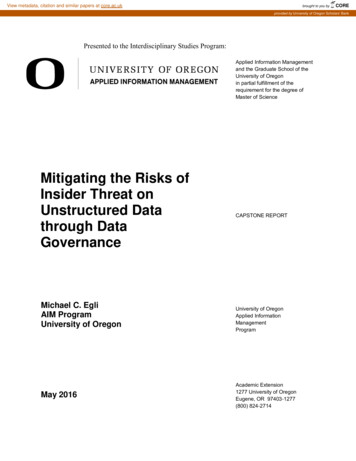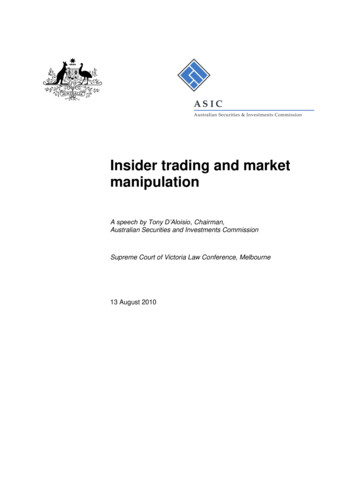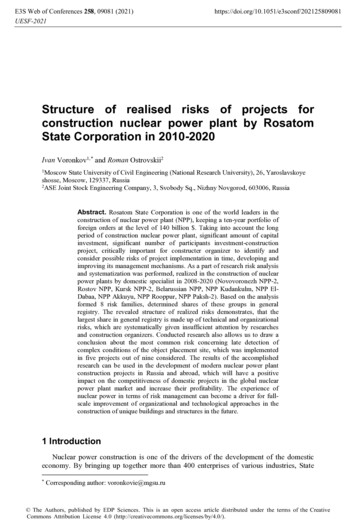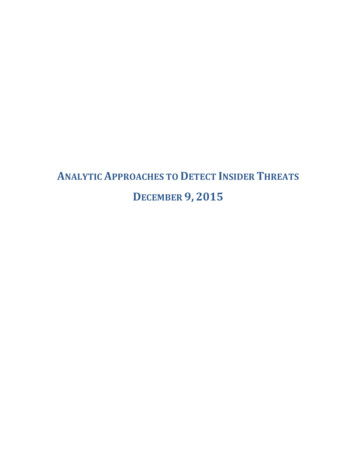
Transcription
View metadata, citation and similar papers at core.ac.ukbrought to you byCOREprovided by University of Oregon Scholars' BankPresented to the Interdisciplinary Studies Program:Applied Information Managementand the Graduate School of theUniversity of Oregonin partial fulfillment of therequirement for the degree ofMaster of ScienceMitigating the Risks ofInsider Threat onUnstructured Datathrough DataGovernanceMichael C. EgliAIM ProgramUniversity of OregonMay 2016CAPSTONE REPORTUniversity of OregonApplied InformationManagementProgramAcademic Extension1277 University of OregonEugene, OR 97403-1277(800) 824-2714
Running head: UNSTRUCTURED DATA GOVERNANCE1
UNSTRUCTURED DATA GOVERNANCEApproved byDr. Kara McFallDirector, AIM Program2
UNSTRUCTURED DATA GOVERNANCEMitigating the Risks of Insider Threat through Data GovernanceMichael C. EgliVaronis Systems3
UNSTRUCTURED DATA GOVERNANCE4
UNSTRUCTURED DATA GOVERNANCE5AbstractThis paper examines the growing risk of insider threat on unstructured data (GartnerResearch, 2015). This review of selected literature identifies the risks and challenges inmanaging unstructured data, and presents best practices for risk mitigation, security and auditcontrols, compliance implications, and technical processes. With implementation of thesepractices, it is feasible that organizations can reduce the probability and impact of an insiderbreach on their unstructured data.Keywords: data governance, unstructured data, insider threat, risk management,compliance, information security
UNSTRUCTURED DATA GOVERNANCE6
UNSTRUCTURED DATA GOVERNANCE7Table of ContentsAbstract . 5Purpose Statement . 11Research Question . 12Audience . 12Search Report . 13Annotated Bibliography . 17References . 48
UNSTRUCTURED DATA GOVERNANCEList of Tables and Figures8
UNSTRUCTURED DATA GOVERNANCE9IntroductionProblemInmon and Nosavich (2008) define unstructured data as an unstructured system that hasform but is rich with text such as emails, contracts, reports, transcriptions, and other documents.The information security industry currently faces exponential growth in unstructured data.Gartner (2013) estimates that the amount of this type of data is growing between 40-60% eachyear, and it is estimated to increase by 800% from 2012 to 2022 (Berry, 2012). As a result,organizations are struggling with not just how to manage the storage of unstructured data, butalso how to continue to make it useful and secure in light of insider threat breaches (Mearian,2010). Recent examples of high-profile data breaches that included high volumes of unstructureddata loss include those at Sony and Target and the unauthorized leaking of National SecurityAdministration (NSA) confidential data by former Central Intelligence Agency (CIA) employeeEdward Snowden (Ponemon Institute, 2015a).Gartner Research (2015) has coined the term “dark data” and describes it as “theinformation assets organizations collect, process, and store during regular business activities, butgenerally fail to use for other purposes (for example, analytics, business relationships and directmonetizing)” (p.1). Unstructured data now accounts for nearly 95% of a typical organization’sdata (Tanwar, Duggal, & Khatri, 2015). In addition, the International Data Corporation (IDC)indicates that over 90% of unstructured data is never analyzed (Pornain, 2014) for the purposesof data classification. The lack of analysis and rapid growth of unstructured data have createdchallenges for organizations, including difficulties in selecting technology to assist with themanagement, storage, and security of the data; the lack of insights from the data; and themitigation of associated risks such as insider threats (Taylor, 2013).
UNSTRUCTURED DATA GOVERNANCE10Recent breaches of unstructured data at organizations such as Sony, the National SecurityAgency, eBay, JPMorgan Chase and Co., and Home Depot have “raised senior managements”level of concern about how cybercrimes might impact their organizations” across the UnitedStates (Ponemon Institute, 2015b, p.1). In a study by the Ponemon Institute (2015b),organizations that were surveyed in 2015 indicated that 67% of them saw an increase in budgetover the last year aimed at defending data breaches. However, in the same study, the PonemonInstitute found that of the organizations with breach detection technology, 45% of those who haddiscovered a breach caught it by accident.Research suggests that although many organizations have implemented technology toimprove security controls, the methodologies to manage the unstructured data and the securitycontrols surrounding them require improved practices (Ponemon Institute, 2015a). In a surveyperformed by the Ponemon Institute (2015b) of 1,006 senior-level leaders in informationtechnology and information technology security in the US, UK, Europe, Middle East, and NorthAfrica, respondents indicated that technology spending to improve security controls through theapplication of technology increased an average of 34% from 2014 to 2015 (Ponemon Institute,2015b). In addition, 35% of these organizations acknowledge that a principle cause ofunstructured data security issues is the lack of in-house expertise, 15% cite poor leadership, and12% identify an incomplete knowledge of where sensitive data exists. A study by Vormetric(2015) consisting of 800 senior business managers and IT professionals indicates that while 49%of the respondents indicate that sensitive data for organizations resides within databases and 39%within file servers, 70% of decision makers were more focused on mobile device protection thanaddressing the volume of at-risk data on these inside storage devices. Although executives haveincreasing concerns about insider threats as a result of recent breaches, and these concerns have
UNSTRUCTURED DATA GOVERNANCE11dramatically increased spending on technology, systems administrators and information securitypractitioners are concerned that the methods in place for securing unstructured data are notworking (Ponemon Institute, 2015a).Organizations that are facing challenges from unstructured data will benefit from datagovernance strategies. However, industry experts such as Christophe Marcant (2015), VicePresident of Product Strategy at Stibo Systems, indicate that while there are many tools availablethat offer governance of unstructured data, they only offer solutions to execute data governanceactivities rather than aiding in the definition of the organizational goals and methods inherentwithin a data governance strategy. Organizations that do not currently manage their unstructureddata will benefit from the documentation of industry best practices that address the need for datagovernance strategies, thus enabling the organizations to begin to turn dark data into managedunstructured data. Doing so can greatly reduce the associated risk of exfiltration (GartnerResearch, 2011) and the resulting expense and loss of customers and company reputation(Filkins, 2015).Purpose StatementThe purpose of this annotated bibliography is to present literature that addresses the needof organizations for a vendor-neutral data governance strategy that concentrates on unstructureddata and the risk of insider threats such as exfiltration. This document endeavors to provideresources on best practices for data governance of unstructured data so that organizations canimplement methodologies to leverage, secure, and manage human-generated data to meetincreasing demands. In addition, this study provides sources that define unstructured data andprovide examples of threats that organizations have faced with regard to the securing of this keyorganizational asset.
UNSTRUCTURED DATA GOVERNANCE12Research QuestionWhat security best practices can organizations implement as part of their data governanceplans to reduce the risk of exfiltration and the exposure of unstructured data?AudienceUnstructured data, mitigating the risks of insider threat, and methods to improve datagovernance strategies are of interest to Chief Information Officers (CIOs) and Chief InformationSecurity Officers (CISOs) according to a study performed by the Ponemon Institute (2015a).This interest has spawned an increase in technology spending in the area of improving securitycontrols an average of 34% since 2014, yet many information technology workers are concernedthat this spending is insufficient. In a 2015 study conducted by the Ponemon Institute, 66% of the1006 respondents indicated that their organizations need more knowledge to effectively managethe threats (p. 16). Therefore, it is crucial that Chief Financial Officers (CFOs) are also informedon these issues as they have an interest in ensuring the budgets allocated to security spending aresufficient to address the continued effectiveness and efficiency of unstructured data, while alsoreducing the risk of loss.The collection and reporting of best practices for unstructured data governance assists inthe creation of effective information security policies and the successful application oftechnology (Marcant, 2015). For example, a study performed by the Ponemon Institute (2015b)identified that of the organizations that had experienced a data breach, 65% indicated the attackevaded existing security controls, yet only 9% of organizations indicate they will spend budgeton sensitive data management as a result. CIOs, CISOs, and CFOs will benefit from a resourcethat documents data governance best practices to improve upon the implementation of strategies
UNSTRUCTURED DATA GOVERNANCE13for ongoing management and security of unstructured data that are now the target of manyexfiltration attempts.Search ReportSearch strategy. The principal method for identifying relevant resources for this research iscentered on the following three steps: Identifying key words and themes; Accessing libraries and research institute databases; and Correlating data between various topics to draw conclusions based on theintersections between discussions on insider threats, data breaches, big data,unstructured data as a subset of big data, data governance, IT spending, IT securitypolicies, incident response, and risk management.Evaluation criteria. Sources are evaluated using The University of Florida’s Center forPublic Issues Education (2014) evaluation criteria. This evaluation process includes identifying ifthe source demonstrates bias, is authoritative, if the content is reflective of quality standards, ifthe material is timely, and if the content of the source is relevant to the subject of this paper.Bias. The topic of this paper is based on a growing issue with insider threats and theunstructured data (Gartner Research, 2015); at the time of this research study there are limitedscholarly resources available on this new and narrow topic. Therefore, vendors who have stakesin the outcomes perform much of the research on unstructured data. To mitigate the risksassociated with the use of potentially biased sources, content is evaluated for authority andaccuracy through the following means: Content is included within this paper if there are statisticsand knowledge gained directly from survey results rather than a presentation of the author’sopinion. Resources used by research firms should be surveys that include respondents from
UNSTRUCTURED DATA GOVERNANCE14multiple industries and positions, or the source must provide clear recommendations on resolvingissues such as data leakage in a vendor-neutral manner without the requirement of specificsoftware purchases. Portions of papers written by vendors who have a stake in selling a servicemust clearly mark which areas are written by the research firm and which are written by thevendor so that a clear distinction can be drawn between survey results written by an authority incomparison to material that reflects a strong potential bias.Authority. Except for the exceptions stated above, academic sources are evaluated byanalyzing their citations and verifying that the document has been peer reviewed and that sourcematerials are relevant to the topic of this paper.Quality. Evaluation of all sources includes the review of punctuation, grammar, flow, andpresentation to validate a level of professionalism exists for the formal publication.Timeliness. The topic of study is a relatively new subject; therefore, sources that have beenpublished after 2010 are sought.Relevancy. A source is selected if it has a key focus on either unstructured data as a mainfocus, or as a subset of Big Data.Documentation approach. References are documented within three individual locations.Initially, they are stored using bookmarks for further review. Once a source is vetted anddetermined to meet the evaluation criteria for inclusion in this study, it is moved to Zoteroalongside a description and the abstract for quick reference. Finally, the source is included withinthe main paper under references and if applicable as an entry in the annotated bibliography. Theannotated bibliography and references section grow throughout the research process to build asolid foundation for the paper as a whole, which aids in writing other sections of the paper oncethe primary research phase is completed.
UNSTRUCTURED DATA GOVERNANCEKey words. Key words, themes and topics include: Unstructured data; Data governance as it relates to unstructured data; Data breaches; Insider threat and unstructured data breaches; IT security policy and data governance; Incident response to data security and data breaches; Risk management and analysis approaches to data governance; Exfiltration, privilege abuse; Impacts of security breaches such as monetary loss and cost of recovery; Mitigating risks related to insider threat (exfiltration, abuse, etc.); Unstructured data management practices for common industry compliances (HIPAA,PCI-DSS, SOX); and IT spending and budgetary impacts.Databases. The following databases are used to identify appropriate sources for thisstudy: Gartner Research; Business Search Complete; Academic Search Premier; Sciencedirect.com; Google Scholar; and JSTOR.15
UNSTRUCTURED DATA GOVERNANCE16
UNSTRUCTURED DATA GOVERNANCE17Annotated BibliographyThe following Annotated Bibliography contains references that provide information onthe impact of insider threat on unstructured data. Topics are focused on key areas including (a)challenges and risks with managing unstructured data, (b) best practices for mitigatingunstructured data risks, and (c) best practices for data governance management. The selectedreferences are intended to set a baseline of best practices that information security andinformation systems administrators can use to implement improved unstructured datamanagement practices that are focused on security, as well as inform executive-level decisionmakers on the importance of implementing a corporate strategy for data governance.Each annotation consists of three individual elements: a bibliographic citation, anabstract, and a summary. Abstracts are provided verbatim when available. Summaries areintended to highlight the key topics presented in the material that best align with the core intentof this paper: To provide insight on best practices on unstructured data governance, and how toreduce insider threat as a result.Challenges and Risks with Managing Unstructured DataBerry, D. (2012, April 9). Unstructured data: Challenge or asset? Retrieved March 30, 2016,from llenge-or-asset/Abstract. Diane Berry presents many statistics backed by major research firms includingIBM, Gartner and the IDC to instruct the reader that unstructured data is a challenge formost organizations. The major struggles experienced by study participants revolvearound the inability to gain value from unstructured data. Coveo, the organization that theauthor works for, performed a study that indicated that 85% of executives felt thatmanagement of unstructured data would have an impact on their ability to serve
UNSTRUCTURED DATA GOVERNANCE18customers (2012), yet a study performed by IBM of 1,500 CEO’s indicated that they havelittle insight and lack the ability to “transform available data into feasible action plans”(2012).Summary. The article references a number of sources including studies by IBM, GartnerResearch and Coveo that relate to the effects of growth in unstructured data. A studyincluding 1,500 CEOs performed by IBM indicated frustration over how to utilizeunstructured data, while Gartner Research predicts that there will be a growth ofenterprise data of 800% between 2012-2017, of which 80% is unstructured. The authorindicates that unstructured data is being semi-structured through the use of powerfulengines that index the data, making it useful for enterprises to meet the need identified bythe CEOs mentioned in the IBM study above. This indexing process is intended to assistorganizations with leveraging the enormous growth in unstructured data so that theinformation within can become an asset. This has led to a paradigm shift wherestakeholders are investing greatly in technology that is predicted will make this datauseful and lead to huge economic value.This article is useful for this study because it provides context for the value ofunstructured data and the challenges that occur with rapid data growth and a general lackof visibility into what is contained within these documents.Bertino, E. (2013). Big Data - Opportunities and Challenges. West Lafayette, Indiana: PurdueUniversity.Abstract. Recent technological advances and novel applications, such as sensors, cyberphysical systems, smart mobile devices, cloud systems, data analytics, and socialnetworks, are making possible to capture, process, and share huge amounts of data –
UNSTRUCTURED DATA GOVERNANCE19referred to as big data - and to extract useful knowledge, such as patterns, from this dataand predict trends and events. Big data is making possible tasks that before wereimpossible, like preventing disease spreading and crime, personalizing healthcare,quickly identifying business opportunities, managing emergencies, protecting thehomeland, and so on [1]. As discussed by The Economist [2] “Managed well, the datacan be used to unlock new sources of economic value, provide fresh insights into scienceand hold governments to accounts”. Unlocking the potential of big data requires howeveraddressing several major challenges. The goal of this panel is to identify and discussresearch directions to address these challenges. In what follows, we first discuss thenotion of big data and application domains where big data is relevant. We then outlinerelevant challenges and summarize questions addressed by the panel.Summary. Bertino explains the importance of what big data provides such as the abilityto gain knowledge and turn that knowledge into practice. Leveraging big data allows forthe advancement in technology such as identifying trends in behavior that can lead toimproved analysis or differences in application behavior to meet user needs. However,Bertino explains that this same volume of knowledge also poses an issue as the data itselfcan be used for other harmful purposes. For example, the data could provide the ability togain knowledge on groups of people for the purposes of discrimination, which highlightsthe importance of population and personal privacy as a principle concern when managinglarge volumes of data. This critical component to the security of big data must include theresolution of related challenges, including the difficulties of securing access tounstructured data to only the users that require it through scalable security administration,inefficient management of unstructured data due to the sheer volume of files and folders,
UNSTRUCTURED DATA GOVERNANCE20and integration of data security policies to govern the practices of security andmanagement. Other important challenges that remain in the domain of data governanceare how information can be cleaned when the information is no longer relevant andassuring that only relevant data is stored.Blanchard, R., & O'Sullivan, K. (October, 2015) Big data risk and opportunity: Having an actionplan to address both can add tremendous value to the organization. Internal Auditor.Retrieved fromhttp://go.galegroup.com/ps/anonymous?id GALE%7CA434320765&sid googleScholar&v 2.1&it r&linkaccess fulltext&issn 00205745&p AONE&sw w&authCount 1&isAnonymousEntry trueAbstract. To an internal auditor, just the term big data can elicit a sinking feeling. Thechallenges associated with the volume, complexity, and variety of big data can beoverwhelming. The good news is, with a solid action plan, internal auditors can do morethan just mitigate the risks associated with big data. Internal audit also can help exploitbig data to identify and mitigate existing risks. Big data is the collection of data sets thatare so large and complex that they are difficult to process using conventional databasetools. Big data comes in two flavors: Structured data (e.g., data in spreadsheets anddatabases) and unstructured data (e.g., social media posts, emails, audio, video, and GPSdata). And, of course, big data can have multiple sources. Typically, working with bigdata requires new technologies to identify usable business insights, trends, andcorrelations — often in real time.Summary. This document approaches big data and unstructured data from an auditor’sperspective and specifically focuses on identifiable risks that the data poses. The authors
UNSTRUCTURED DATA GOVERNANCE21focus on personally identifiable information and the ownership of that data, the impactsof regulatory compliance on the potential sensitive content within documents, exposure toreputation risk if a data breach occurs, and data retention policies. The documentprovides clear guidance on how to address these issues by performing a combination ofinternal audits and creating organizational plans to specifically address governance overbig data. At a high level, the approach involves a five phase plan which includes: (a)identifying where data resides and who owns it, (b) defining organizational goalsregarding the data, (c) assessing critical data issues, (d) identifying key risk indicators(KRIs), and (e) identifying opportunities to add value. The intention is to drive anorganization through this plan and perform routine audits to reduce the risk of theorganization in the event of privacy breaches.Miller, P. (2014). Applying big data analytics to human generated data. Austin, TX: GigaomResearch. Retrieved from ics-tohuman-generated-data/Abstract. As the analytics industry moves to address an explosion in machine-generateddata, another opportunity is already here. Emails, texts, documents, and otherunstructured human-generated data -- and the metadata associated with them -- deliversignificant insight to businesses with the resources and will to mine them. Taking controlof human-generated data provides companies with a more complete understanding oftheir intellectual property, enables them to aggregate business intelligence for sharingwith employees, and allows security professionals to identify and mitigate both casualand deliberate breaches of policy. However, the operational cost of normalizing andmining this data is significant and requires a sound strategic understanding of
UNSTRUCTURED DATA GOVERNANCE22technologies and goals. This research report evaluates the opportunities and challengesassociated with analyzing human-generated data. It examines early adoption in the riskmanagement and governance use cases, and evaluates the potential impact of theseanalytics for other use cases and industries. Key findings include: Human-generated datain word-processed documents, presentations, spreadsheets, and emails typicallycomprises an organization’s most prized assets, including key intellectual property,operating procedures, and the plans and strategies that shape future development. Mostorganizations fail to adequately manage the creation, use, and dissemination of these keyassets. As a result, they either introduce friction into collaboration through excessivelystrict access controls or risk serious data loss by sharing data too permissively. Tools andtechniques from the big data sector offer the means to monitor human-generated dataacross an organization’s different IT environments, protecting key assets and ensuringthat regulatory obligations are met in a cost-effective and timely manner. Datagovernance, audits, and other regulatory requirements are typically the initial drivers fordeployment of these technologies, but other opportunities present themselves oncesystems and procedures are in place. The same tools, for example, can identifyindividuals and teams in different parts of a large organization who happen to beaccessing similar resources without knowledge of one another, brokering introductions toteams that may be tackling complementary problems unwittingly.Summary. The conflict between an organization’s desire for simplicity for file accessrights, such as enabling every user to access any file, and the inherent security risksinvolved with this approach are discussed in this document by Gigaom Research. Theresearch company indicates that challenges in managing data access are not only limited
UNSTRUCTURED DATA GOVERNANCE23to understanding who should have access to which data, but that organizations are alsochallenged by inadequate resources to both identify who needs access and thenimplement the changes as these efforts are cumbersome. The various technologies andprocesses impacted by unstructured data are requiring more resources within theInformation Technology (IT) organization, yet budgets are not available to address theneed. Lastly, organizations struggle to mitigate the risks resulting from overly permissiveaccess rights, a lack of visibility into who should and should not have access, and a lackof staff to make permissions changes and routinely audit them.Ponemon Institute. (2015a). 2014: A year of mega breaches. Traverse City, MI. Retrieved dfAbstract. 2014 will long be remembered for a series of mega security breaches andattacks starting with the Target breach in late 2013 and ending with Sony PicturesEntertainment. In the case of Target breach, 40 million credit and debit cards were stolenand 70 million records stolen that included the name, address, email address and phonenumber of Target shoppers. Sony suffered a major online attack that resulted inemployees’ personal data and corporate correspondence being leaked. The financialconsequences and reputation damage of both breaches have been widely reported.Summary. The Ponemon Institute performed a study that included 735 IT and ITsecurity practitioners, of which 2% were executives, 38% managers, and the remainder amix of consultants and IT administrators. This study provides statistics on how the highprofile security breaches in 2014 such as those experienced by eBay, JPMorgan Chase &Co., Home Depot, CHS community Health Systems, Target and Sony Pictures
UNSTRUCTURED DATA GOVERNANCE24Entertainment affected IT spending, decision making and the overall focus in managingInformation Technology. A significant focus of this document is the technologyinvestments and operational changes made after 2014. While data governance as aconcept was not directly addressed in this document, related topics are discussed such asthe impacts on an organization after data exfiltration occurs; loss in brand awareness,brand value and productivity due to a data breach; and the need to purchase newtechnologies to support better security. An important statistic from this study that relatesdirectly to challenges and risks with managing unstructured data is that 65% of surveyparticipants indicated that attacks evaded existing preventative security controls and 37%indicated that insufficient funding for technology to monitor and prevent breaches was arelated cause (p.10). Following the 2014 breaches, additional budget was granted to IT tospend specifically on mitigations for the risk of data exposure; however, participantsacknowledged that additional spending may not address the issues as they expecttechnology will not mitigate the risks and consequences of the breaches by itself (p.11).Ponemon Institute. (2015b). 2015 Global Megatrends in Cybersecurity. Traverse City, MI.Retrieved lery/documents/content/rtn 233811.pdfAbstract. We are pleased to present the findings of the 2015 Global Megatrends inCybersecurity sponsored by Raytheon. The purpose of this research is to understand thebig trends or changes that will impact the security posture of organizations in both thepublic and private sector in the next three years. Moreover, the study looks at the nextgeneration of protocols and practices as the cybersecurity field evolves and matures. We
UNSTRUCTURED DATA GOVER
Mitigating the Risks of Insider Threat through Data Governance Michael C. Egli Varonis Systems . UNSTRUCTURED DATA GOVERNANCE 4 . UNSTRUCTURED DATA GOVERNANCE 5 Abstract This paper examines the growing risk of insider threat on unstructured data (Gartner Research, 2015). This review of selected literature identifies the risks and challenges in managing unstructured data, and presents best .










